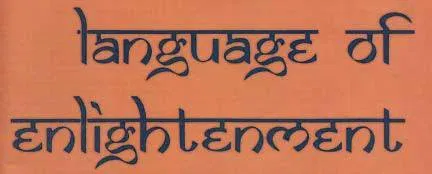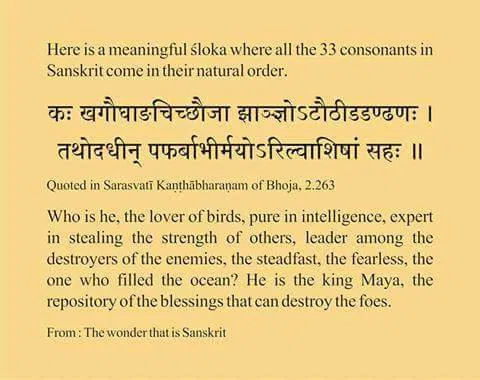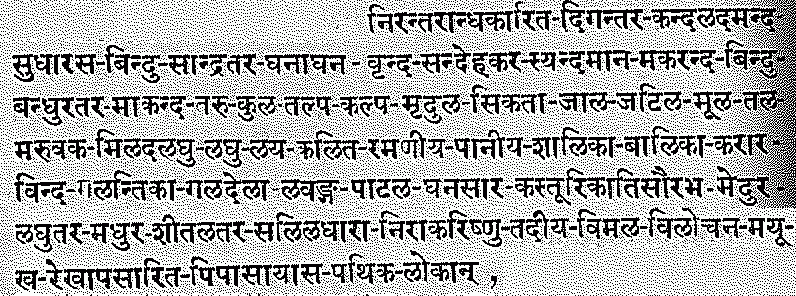What are some mind blowing facts about Sanskrit? Here is something interesting for you…
1. The PI Encription
Encrypting the value of pi in a shloka. – There is a numbering system in Sanskrit called the Katapayadi System. This system ascribes a number to every letter or alphabet in thescript, something similar to the ASCII system in computer science.
Katapayadi system is used to encode numbers in many shlokas
When the letter in the following shloka is replaced with their corresponding number from the Katapayadi Sankhya, we get the value of pi accurate to 31 digits:
गोपीभाग्यमधुव्रात-शृङ्गिश
खलजीवितखाताव गलहालारसंधर ॥
OR
Gopibhagya madhuvrata srngisodadhisandhiga|
Khalajivitakhatava galahalarasandhara||
(The shloka extolls Krishna and his achivements.
Pi using Katapayadi Encryption
ga – 3 pii – 1 bhaa – 4 gya – 1 ma – 5 dhu – 9 ra – 2 ta -6 shru – 5 ga – 3 sho – 5 da – 8 dhi – 9 sa – 7 dha – 9 ga – 3 kha – 2 la – 3 jii – 8 vi – 4 ta – 6 kha – 2 ta – 6 va – 4 ga – 3 la – 3 ra – 2 sa – 7 dha – 9 ra – 2
pi = 3.1415926535897932384626433832792
2. All the Consonants
A sloka in which all 33 consonants come in their natural order, (Varnacitras)
The varnachitras are shlokas written with certain constraints on the use of consonants. For example, here is one in which all the 33 consonants in Sanskrit come in their natural order:
कः खगौघाङचिच्छौजा झाञ्ज्ञोऽटौठीडडण्ढणः।
तथोदधीन् पफर्बाभीर्मयोऽरिल्वाशिषां सहः।।
“Who is he, the lover of birds, pure in intelligence, expert in stealing the strength of others, leader among the destroyers of the enemies, the steadfast, the fearless, the one who filled the ocean? He is the king Maya, the repository of the blessings that can destroy the foes.”

3. Longest Word on Planet
Sanskrit allows word compounding of arbitrary length. Nouns and verbs can be expressed in one word. The longest word ever used in Sanskrit literature is (inDevanagari):
निरन्तरान्धकारित-दिगन्तर-
in transliteration composed of 431 letters, thus making it the longest word ever to appear in worldwide literature.
Each hyphen separates every individual word this word is composed of.
The approximate meaning of this word is:
“In it, the distress, caused by thirst, to travellers, was alleviated by clusters of rays of the bright eyes of the girls; the rays that were shaming the currents of light, sweet and cold water charged with the strong fragrance of cardamom, clove, saffron, camphor and musk and flowing out of the pitchers (held in) the lotus-like hands of maidens (seated in) the beautiful water-sheds, made of the thick roots of vetiver mixed with marjoram, (and built near) the foot, covered with heaps of couch-like soft sand, of the clusters of newly sprouting mango trees, which constantly darkened the intermediate space of the quarters, and which looked all the more charming on account of the trickling drops of the floral juice, which thus caused the delusion of a row of thick rainy clouds, densely filled with abundant nectar.”
4. Total Palindrome
Another one which is a beautiful Palindrome, read the way you like, (Gaticitras)
5. Each Line Palindrome
A verse where each line (pada) of it is a palindrome, and the verse is unchanged when read vertically down or up as well
देवाकानिनि कावादे वाहिकास्वस्वकाहि वा ।
काकारेभभरे का का निस्वभव्यव्यभस्वनि ॥
devākānini kāvāde vāhikāsvasvakāhi vā ।
kākārebhabhare kā kā nisvabhavyavyabhaasvani ॥
Translation: “O man who desires war! This is that battlefield which excites even the gods, where the battle is not of words. Here people fight and stake their lives not for themselves but for others. This field is full of herds of maddened elephants. Here those who are eager for battle and even those who are not very eager, have to fight.”
6. English words derived from Sanskrit
Here’s just a few examples of the english words derived from Sanskrit :
Mother Mathar, Father Pithar, Brother Brathar, SisterS vasar, Daughter Duhitar, Son Sud ,Navy Nav (Naavig), Nine Nau/Nav, New Nava, Diva DivineDevi/Dev,Duo/Duvet/DualDvaya, Two Dva, Three/Trinity/TridentThri
7. Similarities between Sanskrit and Latin
Meaning Sanskrit Latin
“three”
trayas
tres
“seven”
sapta septem
“eight”
ashta
octo
“nine”
nava
novem
“snake”
sarpa
serpens
“king”
raja
regem
“god”
devas
divus (“divine”)
8. Backward
Impressed ?? NO. Ok lets see a semordnilap,
If you read it backwards, it translates to an entirely new sloka, with a valid meaning.
See how they used to literally play with words, but its not enough.
9. One Vowel
A sloka, formed entirely with one vowel, ‘उ ’ (svarcitras)
10. One Consonant
A sloka of 32 syllables with only single consonant, and yes it has a meaning, a valid meaning, (Sthaanacitras)
This shloka of 32 syllables uses only one consonant and one vowel in the entire verse य (ya) and ई (î).
The meaning of the verse is as follows: “The sandals which adorn the Lord, which help in attainment of all that is good and auspicious, which give knowledge, which cause the desire (of having the Lord as one’s own), which remove all that is hostile, which have attained the Lord, which are used for going and coming from one place to another, by which all places of the world can be reached, these sandals are for Lord Vishnu.”
The arrangement of the words of the verse, in their proper prose order-
यायाया (yâyâyâ), अाय (âya), अायाय (âyâya), अयाय (ayâya), अयाय (ayâya), अयाय (ayâya), अयाय (ayâya), अयाया (ayâyâ), यायाय (yâyâya), अायायाय (âyâyâya), अायाया (âyâyâ), या (yâ), या (yâ), या (yâ), या (yâ), या (yâ), या (yâ), या (yâ), या (yâ).
And here is a shloka, where each quarter is written using only one consonant. The first quarter is formed of ज (ja), the second of त (ta), the third of भ (bha) and the fourth of र (ra):
जजौजोजाजिजिज्जाजी तं ततोऽतितताततुत्। भाभोऽभीभाभिभूभाभूरारारिररिरीररः।।
“Balarama, the great warrior and winner of great wars, resplendent like Shukra and Brihaspati, the destroyer of wandering enemies, went to the battle like a lion, stopping the movement of his foes, who were endowed with a four-fold army.”
The Kiratarjuniya has some fascinating examples, like making a verse with only one consonant.
न नोननुन्नो नुन्नोनो नाना नानानना ननु ।
नुन्नोऽनुन्नो ननुन्नेनो नानेना नुन्ननुन्ननुत् ॥
na nonanunno nunnono nānā nānānanā nanu ।
nunno’nunno nanunneno nānenā nunnanunnanut ॥
Translation: “О ye many-faced ones (nānānanā), he indeed (nanu) is not a man (na nā) who is defeated by an inferior (ūna-nunno), and that man is no man (nā-anā) who persecutes one weaker than himself (nunnono). He whose leader is not defeated (na-nunneno) though overcome is not vanquished (nunno’nunno); he who persecutes the completely vanquished (nunna-nunna-nut) is not without sin (nānenā).”
11. Same Feet
A verse where all four feet of the verse are the same, but each foot has a different meaning.
विकाशमीयुर्जगतीशमार्गणा विकाशमीयुर्जगतीशमार्गणाः ।
विकाशमीयुर्जगतीशमार्गणा विकाशमीयुर्जगतीशमार्गणाः ॥
vikāśamīyurjagatīśamārgaṇā vikāśamīyurjagatīśamārgaṇāḥ |
vikāśamīyurjagatīśamārgaṇā vikāśamīyurjagatīśamārgaṇāḥ ॥
Translation: “The arrows (mārgaṇāḥ), of the king (jagatīśa) Arjuna spread out (vikāśam īyuḥ). The arrows (mārgaṇāḥ), of the lord of the earth (jagatīśa), Lord Śiva, spread out (vikāśam īyuḥ). The Gaṇas (gaṇāḥ) who are the slayers of demons (jagatīśamār) rejoiced (vikāśam īyuḥ). The seekers (mārgaṇāḥ) of Lord Śiva (jagatīśa), i.e. the deities and sages, reached (īyuḥ) the sky (vikāśam) [to watch the battle]. ”
12. The Geometry
The most beautiful , Citrabandhs (when letters of sloka are written out , they form interesting geometric patterns).
Let’s look at the most interesting one,
Knight’s tour problem , is an interesting problem in mathematics, relating to chess, where a knight has to visit each and every square of chessboard only once.
Euler is considered to be the first one to investigate this problem. But, but wait, before you acknowledges him of his genius (no doubt on that, he was), look at this sloka, from‘Padukasahashram’ (written in praise of wooden sandals of Lord Rama by Tamil saint Shri Desikan).
Lets write them in order on a plain paper, like this,
(note each part has same no of syllables)
Now another sloka, following this is ,
Find the syllables of this sloka on the chart we have prepared using syllables of earliersloka. Let us mark them 1,2,3,4….
If you carefully observe the path followed while going form 1 to 2, 2 to 3, it resembles the path of a knight on chess board.
And it traverses all the squares, exactly once.
When you reach at 32, the last one, just take your knight one more step to left, and you are ready to traverse the left half of our chessboard.
But all these are known as ‘adhamkaavyas’ , meaning ‘poems of lower quality’, as they are slow and difficult to understand.
Ironical indeed (for us), who knows if they had creations better than these too, if these are of lower quality.
Facebook Comments













